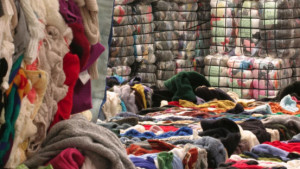 A new piece of industry research published today shows that previous estimates of the amount of clothes donations being stolen are over-stated.
A new piece of industry research published today shows that previous estimates of the amount of clothes donations being stolen are over-stated.
The report by the Textile Recycling Association shows a marked decrease in textile theft across London, with as few as 1.8% of doorstep donations being stolen in the London boroughs where the investigations took place. Previous estimates had suggested that up to £50 million a year was being lost to UK charities – whereas other estimates suggested that up to 15% of all used clothing donations were being stolen.
The research is the first of its kind to quantify actual theft in a defined geographic area. It investigated theft taking place from two different types of clothing donations: doorstep collections, often run by charities that post bags through doors and pick them up on a specified date; and textile banks, located on streets and in car parks around the capital.
The report also identified a number of reasons why textile theft had fallen so dramatically, including a fall in textiles prices and proactive policing.
Alan Wheeler of the Textile Recycling Association said: “It’s really good to know that the vast majority of donated clothes are being collected as they should be, with much of the money raised going to charitable causes or for the benefit of the taxpayer. We had anecdotal evidence that thefts were in decline but no solid figures to reassure the public.”
“This research has confirmed what we have been seeing on the ground within our network over recent months”, says Michael Lomotey of Clothes Aid, a social business which raises funds for UK charities via a door-to-door clothes recycling service.
The number of thefts reported to the police within the M25 has gone down from 110 in 2011 to only 14 so far in 2014. Michael asserts: “We believe the decrease in doorstep collection thefts can be attributed to the rise of proactive policing on these types of crimes. We are working closely with the police providing information on thefts across the country, and have found that local forces are becoming more and more diligent at prosecuting the ring leaders.”
In addition, bogus charity bags or unlicensed collectors are on the wane: as part of the research, volunteers from across London sent in charity bags that had been put through their letterbox over a month, and these were checked by the research team. All of the bags received were charitable collections, and every single one had the necessary legal requirements in place to collect clothes in this way.
People considering donating clothes using a collection bag can carry out a few simple checks to make sure their clothes end up where they’re intended:
• Do they have a registered charity number?
• Does the bag have a ‘give with confidence’ tick? This is a stamp of assurance from the Fundraising Standard Board (FRSB).
• There should always be contact details and a working landline number displayed on the bag – ring if you’re in doubt.
• All charities need to obtain either a ‘National Exemption Order’ or a licence from their local licensing authority to collect in their area. To check whether a collection is genuine, either look at the list of National Exemption Order holders at www.gov.uk or, in London, contact the Metropolitan Police or City of London Corporation.
Thefts from textile banks were higher than doorstep collections but still reduced from previous estimates. The research found that up to approximately 4.7 tonnes of textiles could potentially have been stolen from 32 different banks across three boroughs during the period of the trial – a loss representing around 10% of the total amount of clothing collected during the trial.
“In the last year we’ve seen a definite reduction in theft”, says Ross Barry, from textile recyclers LM Barry, “and that’s partly as a result of introducing stronger banks and improved chute designs which have stopped people either climbing in or cutting the bank open. But 10% still represents a reasonably high percentage, so using the recommendations from this research, we’ll keep improving bank designs to cut down on theft – while making sure they remain easy for the public to use.”
The report also makes a range of recommendations about anti-theft initiatives, and these are being shared with textile bank operators across the capital to help reduce theft even further in the future.
In addition to the research taking place on textile bank sites and along residential streets, the team ran a survey of a number of re-use and recycling organisations involved in clothing collection in London.
All those organisations interviewed had recently observed a decline in theft. This was largely attributed to the declining market prices for used textile materials, although an increase in the number of prosecutions taking place and more active policing of this kind of crime was also cited. There was a significant uplift in reporting of theft during 2011 when used textiles prices reached a critically high level, but prices then plateaued and have substantially declined in 2014.
Alan Wheeler of the Textiles Recycling Association is pleased with the research findings. “Many industry stakeholders have reported a decline in illegal collections and feel that this is at least in part due to the market decline”, he states, “so the current difficult conditions may have provided a silver lining. However, we urge all relevant stakeholders to remain vigilant, take heed of the recommendations made in this report and where necessary instigate new measures to reduce theft levels even further.”




